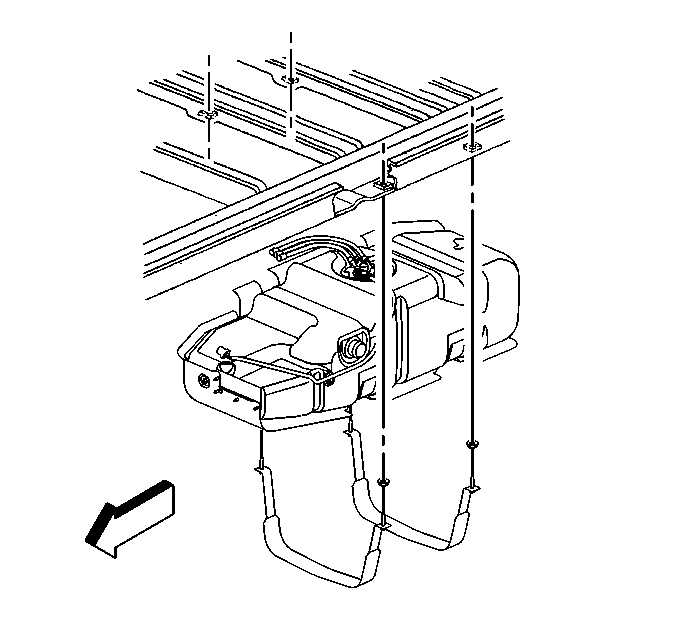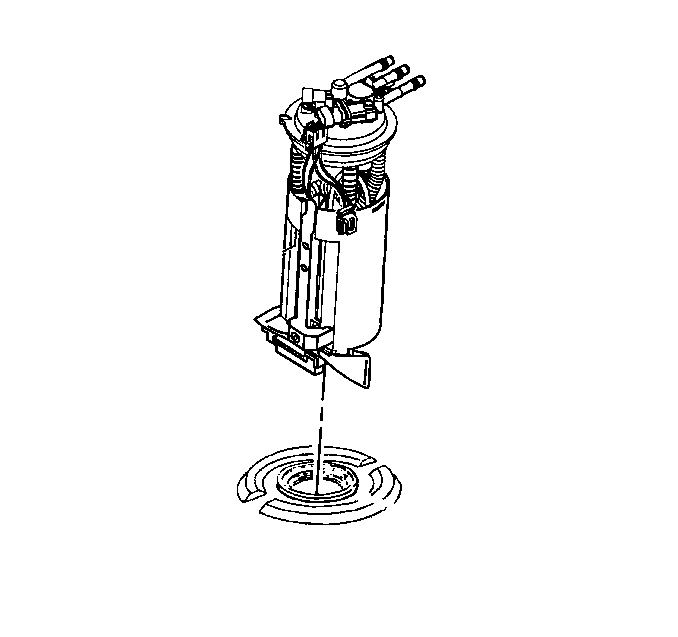Removal Procedure
Tools Required
J 39765 fuel sender locknut wrench
- Disconnect the negative battery cable.
- Drain the fuel tank. Refer to Fuel Tank Draining .
- Raise vehicle. Refer to Lifting and Jacking the Vehicle in General Information.
- Loosen the filler neck hose clamp at the fuel tank.
- Disconnect the fuel tank filler neck from the fuel tank. Refer to Filler Tube Replacement .
- Disconnect the fuel tank lines (5) from the fuel feed (6), fuel return (4), and EVAP (7) chassis pipes.
- Support the fuel tank.
- Remove the tank straps and fuel tank shield.
- Lower the fuel tank enough to access the top of the fuel tank.
- Remove the fuel sender shield from the top of the fuel sender.
- Disconnect the electrical connections at the sender.
- Lower the fuel tank.
- Remove the fuel sender lock ring, using the tool J 39765 .
- Remove the fuel sender and seal ring.
- Discard the old seal ring.
Caution: Unless directed otherwise, the ignition and start switch must be in the OFF or LOCK position, and all electrical loads must be OFF before servicing any electrical component. Disconnect the negative battery cable to prevent an electrical spark should a tool or equipment come in contact with an exposed electrical terminal. Failure to follow these precautions may result in personal injury and/or damage to the vehicle or its components.
Caution: To avoid any vehicle damage, serious personal injury or death when major components are removed from the vehicle and the vehicle is supported by a hoist, support the vehicle with jack stands at the opposite end from which the components are being removed and strap the vehicle to the hoist.



Installation Procedure
- Install a new seal ring.
- Reinstall the fuel tank sending unit.
- Reinstall the fuel tank sender lock ring using tool J 39765 .
- Install the fuel tank bottom shield with insulator strips in place.
- Raise the tank under the vehicle to allow reconnection of electrical connections.
- Install the fuel sender shield on top of the fuel tank.
- Raise the tank fully.
- Reconnect the fuel tank lines (5) to the fuel feed (6), fuel return (4), and EVAP (7) chassis pipes.
- Reinstall the fuel tank filler neck to the tank. Refer to Filler Tube Replacement .
- Install the fuel tank brackets with insulator strips in place.
- Loosely assemble the inboard bolts and spacers through the fuel tank brackets to the frame mounted weld nuts.
- Loosely assemble the outboard bolts, washers, spacers and jamb nuts through the fuel tank brackets to the frame mounted jamb nuts.
- Tighten the inboard strap bolts first.
- Tighten the outboard strap bolts next.
- Tighten the jam nuts against the side rail (outboard) last.
- Lower the vehicle.
- Replenish the fuel.
- Reinstall the fuel tank filler cap.
- Reconnect the negative battery cable.
- Inspect for leaks.

Notice: Do not fold or twist the strainer when installing the sending unit. This action restricts fuel flow.

Ensure the ground strap is reinstalled to the body.

Notice: Tighten the strap fasteners by steps, alternating between the fasteners, until the specified torque is reached. A failure to tighten the strap fasteners as specified will cause the bottom of the tank to flex upward. This will result in the fuel gauge indicating that there is fuel remaining in the tank when the tank is empty.
Important: When removing or replacing the fuel tank, the fuel tank support fasteners should never be reused. Always use new fasteners when installing the fuel tank.
Notice: Use the correct fastener in the correct location. Replacement fasteners must be the correct part number for that application. Fasteners requiring replacement or fasteners requiring the use of thread locking compound or sealant are identified in the service procedure. Do not use paints, lubricants, or corrosion inhibitors on fasteners or fastener joint surfaces unless specified. These coatings affect fastener torque and joint clamping force and may damage the fastener. Use the correct tightening sequence and specifications when installing fasteners in order to avoid damage to parts and systems.
Tighten
Tighten the inboard strap bolts to 35 N·m (26 lb ft).
Tighten
Tighten the outboard strap bolts to 9 N·m (80 lb in).
Tighten
Tighten the jam nuts to 35 N·m (26 lb ft).
If a memory retention device was not used, please reset (to the extent possible) all devices that lost their memory after the battery was disconnected.
| 20.1. | Turn ON the ignition for 2 seconds. |
| 20.2. | Turn OFF the ignition for 10 seconds. |
| 20.3. | Turn ON the ignition. |
| 20.4. | Inspect for fuel leaks. |
